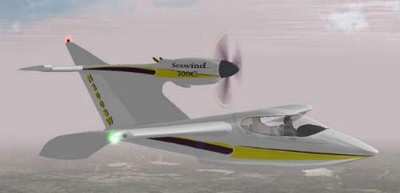Mon, Sep 05, 2005
 The Seawind Company has elected to
complete certification of the Seawind 300C with the Continental
IO-550-N and to offer the Full Authority Digital Engine Controls
(FADEC) as an option. Company President, Richard Silva, said the
selection was based on the Continental engine meeting and exceeding
the criteria of a smooth running 6 cylinder 300 horsepower engine.
The IO-550-N produces 310 H.P. with no increase in weight.
The Seawind Company has elected to
complete certification of the Seawind 300C with the Continental
IO-550-N and to offer the Full Authority Digital Engine Controls
(FADEC) as an option. Company President, Richard Silva, said the
selection was based on the Continental engine meeting and exceeding
the criteria of a smooth running 6 cylinder 300 horsepower engine.
The IO-550-N produces 310 H.P. with no increase in weight.
“We are excited with the selection of the new power plant.
It will give us increased performance, reduced pilot work load and
significant fuel savings.” Silva (pictured below)
explains.
“We are also following, with great interest, the progress
being made in certifying this engine with FADEC for 94 octane auto
gas.”

Offering the certified FADEC as an option provides the latest
technology in power plant design and provides 5% more take off
power as well as a 15% reduction in fuel consumption. Seawind has
also selected the Hartzell Scimitar propeller which is estimated to
boost performance by 3%. Combining all of these positive
developments should result in an increase of over 6% in cruise
power over the original 300 HP power plant. Take off power for
amphibious aircraft is more critical than for land planes, with the
FADEC, the certified Seawind will achieve over 11% increase in take
off power. All of this is an estimate and Seawind will not increase
its published performance specifications until the flight test
results are confirmed and certified this fall. Instead, the proven
specifications of the 300 HP kit versions will continue to be used.
The Seawind is the fastest amphibian in the world having achieved
200 MPH top speed.

Silva says “During the certification process we have been
paying close attention to detail. With the latest 3D modeling
technology we have achieved mold and assembly tolerances within
thirty thousandths of an inch. We recorded every minor improvement
that we wished we could have made in the kit version and have
included them into the new certified tooling. For example, an
additional upgrade to the certified Seawind will result in
considerable drag reduction from the new trailing link landing gear
which now tucks fully into the wings.”
First articles for final flight testing will be rolled out this
fall. The certified Seawind 300C should complete flight testing and
certification this year.
More News
Light Gun A handheld directional light signaling device which emits a brilliant narrow beam of white, green, or red light as selected by the tower controller. The color and type of>[...]
"The journey to this achievement started nearly a decade ago when a freshly commissioned Gentry, driven by a fascination with new technologies and a desire to contribute significan>[...]
Aero Linx: JAARS, Inc. For decades now, we’ve landed planes on narrow rivers and towering mountains. We’ve outfitted boats and vehicles to reach villages that rarely se>[...]
"Our driven and innovative team of military and civilian Airmen delivers combat power daily, ensuring our nation is ready today and tomorrow." Source: General Duke Richardson, AFMC>[...]
Aircraft Conflict Predicted conflict, within EDST of two aircraft, or between aircraft and airspace. A Red alert is used for conflicts when the predicted minimum separation is 5 na>[...]
 ANN's Daily Aero-Term (04.20.24): Light Gun
ANN's Daily Aero-Term (04.20.24): Light Gun Aero-News: Quote of the Day (04.20.24)
Aero-News: Quote of the Day (04.20.24) ANN's Daily Aero-Linx (04.21.24)
ANN's Daily Aero-Linx (04.21.24) Aero-News: Quote of the Day (04.21.24)
Aero-News: Quote of the Day (04.21.24) ANN's Daily Aero-Term (04.21.24): Aircraft Conflict
ANN's Daily Aero-Term (04.21.24): Aircraft Conflict





